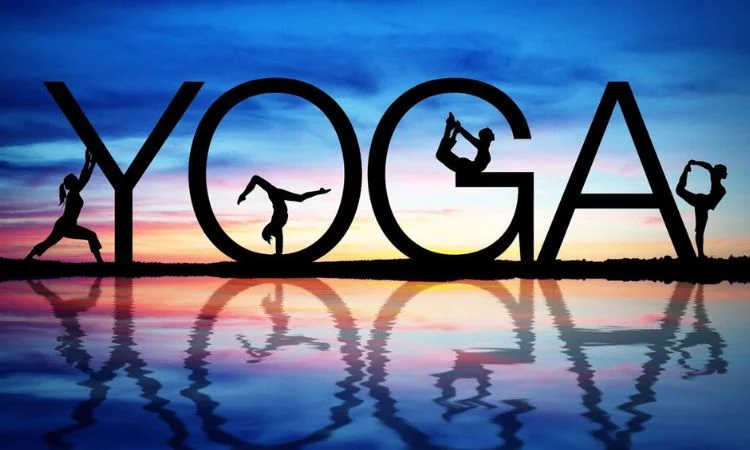Yoga is not only physical exercise – it is a complete framework of principles that could help you change your life for the better. Whether you have been practising yoga for years, or barely knowing what it is, knowing the versatility of the benefits of the practice can help motivate you to continue practising yoga for the rest of your life.
Yoga is known to have a lot of benefits ranging, from flexibility and strength to mental health which include destressing.

Here Below The List Of 10 Benefits Of Yoga
| Benefits of Yoga |
| Improves Flexibility |
| Increased muscle strength and tone |
| Improves Posture |
| Protects Cartilage and Joint Structure |
| Guards the Spine |
| Improves Bone Health |
| Increases Blood Flow |
| Increases Heart Health |
| Helps in De-stressing and Enhancing Mood |
| Relaxes the Nervous System |
Improves Flexibility
Flexibility is one of the hallmarks of yoga and is a benefit that is seen almost as soon as yoga practices are begun. The regular performance of numerous postures and stretches will eventually cause flexibility in your joints, improved mobility, and general freedom from acknowledged quotidian discomforts.
There is a rather deep relationship between flexibility and well-being. Skeletal muscles become rigid and cause the body to degrade, which in turn results in knee, hip and back complications. Indeed, yoga can prevent the deterioration of these areas and help to bring balance and heal the body if done in the right areas of focus.
However, increased flexibility is by no means solely a benefit within the context of workouts; it may make ordinary tasks and actions of your day more easy and comfortable. It is when one is stretching to get something on a high shelf or stooping while tying his or her shoelaces or just walking without strain, the positive effects of flexibility will be noticeable almost anywhere in the body.
Increased muscle strength and tone
Increased muscle strength and tone are essential aspects of fitness and overall health. Muscle strength refers to the amount of force a muscle can produce, while muscle tone refers to the muscle’s firmness and readiness for action, even at rest.
Here are some key points about increasing muscle strength and tone:
Benefits of Increased Muscle Strength and Tone
- Enhanced Physical Performance: Stronger muscles improve your ability to perform daily tasks and engage in physical activities with more power and endurance.
- Improved Metabolism: Muscle tissue burns more calories than fat tissue, even at rest, which can aid in weight management.
- Better Posture: Strong muscles, particularly in the core, contribute to better posture and reduce the risk of back pain.
- Injury Prevention: Strengthened muscles provide better support to joints, reducing the likelihood of injuries.
Improves Posture
Sitting with one’s back slumped and head and shoulders rounded puts stress on the back and neck and other muscles and joints. Because of our sedentary lifestyle in front of screens and for those working desk jobs, it has become crucial to implement a practice that helps to neutralise and muscular the necessary parts of our anatomy.
Well, yoga comes to the rescue, which if embraced has potential to revolutionalize your posture. Yoga consists of rather specific exercises that focus on certain muscles and since its main purpose is to teach a person to observe his positioning carefully and to have the required muscles engaged to be able to maintain a good posture.
With regard to the vertebral column yoga exercises particularly the back, chest as well as the abdominal muscles to maintain the normal curves of the spine hence avoiding distortions due to bad posture. Besides lowering the chances of experiencing pain and discomfort throughout the interaction, friIKs also facilitate clients to convey solidity and substance, physically and metaphysically.
Protecting Cartilage and Joint Structure
Another of the less obvious yet highly significant advantages of having a yoga practice stated that it helps to avoid the ‘use-and-throwaway’ model of joints at a very microscopic level. Such an emphasis is fully justified, as the condition of our joints and cartilages is one of the key factors in maintaining a high level of mobile activity in the later stages of our lives.
Studies have also revealed that daily practice of yoga can be beneficial in not only slowing down the cartilage degeneration which is a crucial material of the human joint. Most of our joints contain synovial fluid that is necessary to feed and cushion them and through an effective yoga practice, all the joints in the body undergo circular movements to help pump the synovial fluid.
In addition, the exercises and postures practised in the course of yoga make the joints stronger and more stable and thus the chances of causing more damage to the cartilage are minimized.
Guards the spine
No wonder that spine health and its proper functioning remains unnoticed and, at times, unworried, although it is one of the most important conditions for a comfortable life. Luckily, what is practised in yoga provides a positive way of emphasising and safeguarding this important structure.
It is important to know that the spinal discs are dynamic structures and a yogic practice that incorporates back bends, forward bends and twists will serve to keep the disc hydrated and nourished. It is also through these movements that the healthy fluid that is needed to nourish the disc is circulated thus avoiding wearing of the discs and development of conditions such as slipped discs or bulging discs.
In addition, with yoga, the core and back muscles become firm hence providing support to provide support and stability for the spine thus relieving the amount of stress that is put on the spine from different activities and postures.
But this is a correct approach to spine health that can be beneficial in terms of diminished pain in the back area, better positioning of the body, and increased physical activity.
Impresses On Bone Health
Perpetual development of the strength of the bones is fundamental to great fitness and extended life. I am happy to report that there is a readily available solution to help promote bone health and the prevention of osteoporosis – the practice of yoga.
Because a great number of yoga positions engage a person in lifting his or her own weight, doing yoga contributes to weight-bearing exercises which are important in building bone mass density.
There are yoga positions that help to put the pressure on arm bones, which are fragile in osteoporotic women: yoga Downward-Facing Dog (Adho Mukha Svanasana) and yoga Upward-Facing Dog (Urdhva Mukha Svanasana).
Increases Blood Flow
Yoga is a set of exercises that similarly affect the circulatory system to improve the supply of blood as well as nutrients and oxygen to cells and tissues.
In the course of yoga training, one discovers that a number of the postures and movements increase circulation by working on the heart. During different body postures, you are obviously exercising the muscles and, as an effect, blood circulation around the body improves.
In addition, the technique of breathing that is normally used when practicing Yoga is also known to assist in circulation of blood to various parts of the body. By increasing the size of the lungs and diaphragm you are in essence trying to increase the blood’s ability to feed and support other organs and tissues.
Increases Heart Health
Indeed, yoga is known to have a vast positive effect on the human cardiovascular system, which adds to the argument why more people should take up yoga to reduce heart diseases.
Looking at the general aspects that can affect heart health, yoga has the potential to affect the following aspects in a manner that is beneficial to the heart. It has been found to reduce the pressure inside the blood vessels, the cholesterol concentrations and blood glucose concentrations which all are signs of cardiovascular health.
However, yoga poses and movements such as Vinyasa or Power Yoga can be classified as aerobic movements that help to strengthen not only the heart muscles.
Helps in De-stressing and Enhancing Mood
This is one of the most significant and perhaps the most long-term effects that practising yoga can have on you – stress alleviation and mood elevation. Yoga is a set of activities, which comprises exercises involving the style both in movement and breathing into, and meditation, that enhances the well-being of both the heart and mind.
Yoga, which helps stimulate the ‘rest and digest’ part of the nervous system, can offset the effects of long-term stress. It triggers the production of happy hormones such as endorphins and gamma-aminobutyric acid (GABA) that have a positive role in the enhancement of mood and the suppression of the symptoms of anxiety and depression.
Relaxes the Nervous System
Yoga, however, is not limited to the physical level, it has a lot of benefits to the nervous system as well. With the practice of conscious breathing, mindfulness, and specific low impact movements, yoga has the potential to centre the mind and stimulate the PNS and thus the ‘rest and digest’.
In the world we live in today where stress is almost a norm the sympathetic nervous system is very much at work and thus making people experience anxiety, tension and even burnout. Yoga here acts as an opposite approach of training the body to tone down and go to a state of rest or repair.
Conclusion
That’s why, as continued in the article, yoga is so valuable in daily practice, which is much more than simple physical exercise.
With added flexibility and muscle strength to better cardiovascular health and decrease in stress, yoga is productively one of the most common disciplines anyone would want to help transform and empower themselves.
Whenever you progress into the course and experience the different facets of Yoga, remember to look for benefits it brings in your lifestyle. Facetiously, observe the less obvious changes in your gait, the ever improving fluency of the physical fluidity of the body, the resultant more serene mental attitude, and the overall improvement in your life styles.















